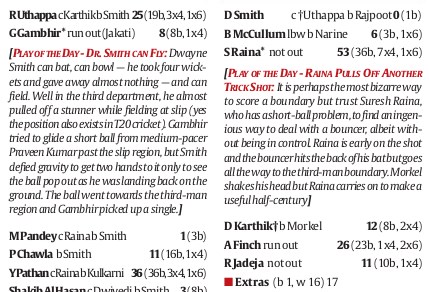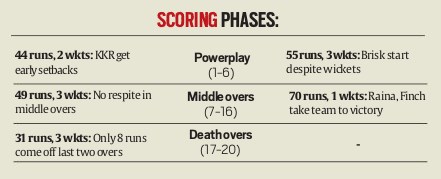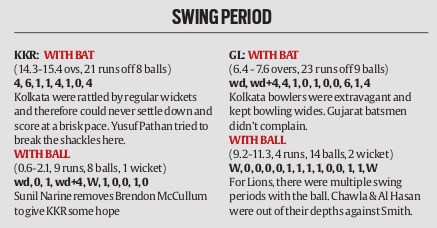We were talking T20 scorecards on Friday and this led to a discussion about whether the traditional form is actually fit for purpose. Our point was that in a T20 match, it’s not just ‘how many’ and ‘how quickly’ – it’s also about when runs are scored and when wickets are taken.
We were subsequently directed towards Mihir Vasavda on Twitter. Mihir writes for the Indian Express and they have apparently been presenting IPL matches rather differently. You can see a sample page here.
Of obvious relevance to our ‘what happens when’ line of thinking is the overs-runs graphic at the bottom, which presents an overview of runs and wickets in each innings over-by-over.
 This, in our opinion, gives a better overview of the respective teams’ performances, although it lacks the detail about which players contributed.
This, in our opinion, gives a better overview of the respective teams’ performances, although it lacks the detail about which players contributed.
For that, it’s back to the traditional scorecard, but even here there are a couple of innovations. For a start, the team totals are immediately followed by tallies of sixes, fours and dots, which gives you a feel for how each side went about its task.
There’s also a chunk of editorial placed at the relevant chronological point within the scorecard proper.
Other informative little segments in the same sidebar include one allowing you to compare performance across the three main phases of the innings…
… a Zero/Hero section focusing on dot balls…
… and ‘Swing Period’ which seems to be about shorter phases of play where each side appeared to be taking the initiative.
Now this is obviously all supplementary to a traditional scorecard, but it does tell the story of the match in a simple and intuitive way – which a traditional scorecard doesn’t.
You don’t have to read a full report, you can just quickly scan for key information and we’re sure that the more familiar you become with this way of presenting the information, the more quickly you can pick up the key details.
Hat tips to Marees and Whistling Dogs for steering us towards Mihir and more of a bow to the Indian Express’s Daksh Panwar who is apparently responsible for coming up with much of this.
We’re sure other newspapers have their own great ways of presenting and elaborating on T20 scorecards, but this struck as being a particularly good example worth sharing.







I would like online reports to carry a gif of a Frenchman, who dances in a way that relays the key moment in the match
Something similar to Brass Eye’s Answer Prancer?
Linked hereinly, I hope.
https://www.youtube.com/watch?v=PfXP1KbXPXQ
I’ve always liked the worms and manhattans which perform a similar function but are much more visual. Never really a fan of that WASP stat that sky do though (Or those bees that interrupted the recent SA SL match for that matter)
I am also a fan of the worms and manhattans, although I find it annoying when the worm charts on Cricinfo consistently default to only showing the current innings. The whole point of the worm chart/graph is to be able to compare different innings.
My worms share the same feelings as your worms
Actually the “over by over” analysis has been around since the relatively early days of T20. The official scorecard thingie from the 2008 T20 Final, which has pride of place on my office wall at the flat, has such an analysis on it.
We had a lengthy discussion (I think here on King Cricket) some while ago suggesting that number of dot balls is an important statistic in T20. Very soon after that discussion, we started to see that stat quoted occasionally and now more regularly.
I’d dig out that massively influential earlier conversation, if I could be bothered to look.
Indeed I don’t think you know how very influential your site is, KC. Nor how relentlessly dedicated are your subjects to your causes.
That’s right, KC! I will not hesitate a minute to sacrifice the life of any one of Ged or Bert or Sam or BailOut to uphold your causes. The problem is, I don’t know what they are. Can we have a powerpoint presentation on your causes — please elucidate on the ones that demand immediate revolution in the form of protests and subsequent loss of lives.
I was quite happily rolling with this one until it got to the “loss of life for the cause” bit. Specifically, I struggled when I saw my name on the list of possible casualties.
Get a sense of proportion, Deep Cower. And a sense of political pragmatism. The winning cause is usually the one whose supporters are alive at the end of the tumult, not the one that goes for meaningful sacrifices.
I did like the bit about KC elucidating what these causes (which we support emphatically) actually are. It would be helpful to see all of that set out in fewer than 500 words. It can’t only be rotund allrounders, indifferent cats, runtime error top trumps and Bob Key…can it?
What are this site’s causes?
What AREN’T this site’s causes?
Although we do have a manifesto in the right-hand sidebar.
Although we really don’t think it’s appropriate to this site to be willing to take any sort of action whatsoever regarding anything.
Great, sounds like we’ve been spared, fellas.
Our king is wise, our king is merciful, our king is manifestly inactive.
Phew, no lives lost in the Second (Division of the County Championship Doesn’t Count) World War.
Although hearing a revolutionary run headlong towards the ICC HQ in Dubai screaming ‘Test cricket can never diiiiiiiiiiiiiiiie!’ would be quite the sight.
Imagine the revolutionary chanting “Play fewer matches” outside the ICC HQ and tell me that won’t incite violence.
Charge of the (what is bad) Light Brigade?
Battle of Ypres the Ashes an event.
The Bridge on the River Kwai wickets, not runs, are what’s important.
For rotund all-rounders of the Samit Patel and Ian Austin variety, the Battle of the Bulge.